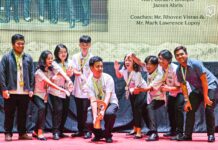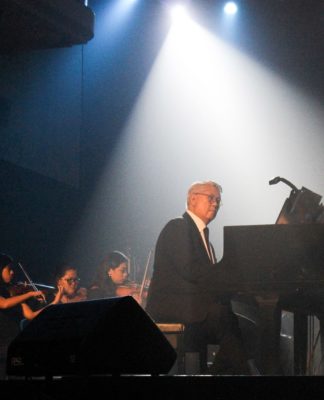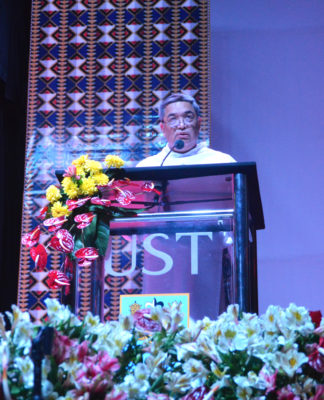
NEW TOOLS, same rules.
New technology may have altered the landscape of journalism, but its goal of informing, educating and stimulating positive change remains.
Such was the primary message conveyed by journalists during the 16th edition of Inkblots, the annual National Campus Journalism fellowship organized by the Varsitarian.
Broadcaster Mike Enriquez of GMA Network sees journalism as “vocation,” one that requires commitment.
“It is a calling. Mahirap maging alagad ng media,” Enriquez told some 250 fellows last Dec. 1 at the Thomas Aquinas Research Complex (TARC) Auditorium.
“Fame and glory are not why we are in media. Some people fail to realize that this aspect of media is fleeting. If you don’t want challenges, then you are not fit to be in media because this is what it is all about.”
Credibility and compassion
Inquirer.net editor in chief John Nery tackled online journalism, which he described as “accessible and interactive.”
“The power of journalism does not lie on technology. It relies on credibility,” Nery said.
ABS-CBS senior reporter Willard Cheng, a three-time Inkblots fellow, talked about broadcast journalism and emphasized the importance of accuracy in reporting.
“It is better to be late and correct than to be the first in reporting but dead wrong,” he said. “It is important to research before going on a coverage.”
UST journalism professor Felipe Salvosa II discussed the basics of news writing while Fr. Nick Lalog, lawyer Jose Sison, and broadcast journalist Joey Villarama sat in a panel that tackled Catholic journalism. For the upcoming papal visit, they urged journalists not to editorialize or sensationalize in their reports.
“It is Christ deciding to visit the Philippines,” Lalog said.
The afternoon session was graced by the presence of reigning Philippine Basketball Association most valuable player June Mar Fajardo and San Miguel coach Leo Austria who sat in a mock press conference. They accompanied Philippine Star columnist Quinto Henson who talked about sports writing.
Understanding your audience
Palanca awardee and UST professor Eros Atalia discussed Filipino journalism and stressed the importance of the mother tongue (Filipino language) in different forms of media as he opened the second day of the Inkblots.
“Sino ba ang media? Ano ba ang mas naiintindihan nila? Sa katotohanan, mas malaki ang sirkulasyon ng tabloid kahit pagsama-samahin ang sales ng broadsheet,” he said. “Mahalaga ang Filipino bilang lingua franca upangmakipag-ugnayan sa mga mamamayan sa ating bansa.”
Christian Esguerra, senior reporter for the Philippine Daily Inquirer and founding father of Inkblots, tackled campus journalism management. He highlighted the importance of promoting a “culture of excellence” in student publications.
“Every publication should establish a system of news production adjusted to the staff’s schedule,” Esguerra said. “Build a set of principles defining responsibilities an accountabilities of students.”
Thinking outside the box
Esquire Philippines’ editor-at-large Sarge Lacuesta urged aspiring literary journalists to be imaginative.
“You have to create your own internal strategies to tell your stories because creative nonfiction is not a straight report. It is creative where the writer has a personal investment,” he said.
He said the main problem of writers today is not about having an inspiration but obtaining a “moment of silence.”
Nestor Cuartero, veteran journalist and long-time editor of the entertainment section of the Manila Bulletin and Tempo, headed the session on feature writing.
“Do not write all the details when you make your piece because you have to leave something to your readers’ imagination,” Cuartero said.
He also reminded the fellows to never cut and paste statements and facts from other sources without proper attribution on their articles.
Cuartero brought in actor Aljur Abrenica for a mock press conference.
Dennis Sabangan, European Pressphoto Agency’s chief photographer, set his talk on becoming a master hand of photojournalism.
“A photojournalist enriches his craft through experience,” Sabangan said. “So if you see something that is extraordinary, make sure that you capture it.”
Returning this year to lecture on editorial cartooning, Manix Abrera, creator of Kiko Machine, encouraged fellows to develop their own style and technique in making their cartoons.
RP Daily ExposE art director and Samahang Kartunista ng Pilipinas director Ivan Anthony “Tony” Hirro underscored how digital technology continues to nurture the design in layouting.
“Digital technology has helped usher and nourish a new era in Philippine print journalism,” Hirro said.
Nery returned on the last day for a session on editorial and opinion writing.
“Most people have very limited time to read what you wrote so you should start by giving a summary lead. Second, simplify your arguments by giving a few points. Third, substantiate your arguments. Lastly, end it with a punch line,” he said.
Nery tied up the three-day fellowship with a quote from Associate Justice Reynato Puno, “The most important of the press in a free society is to inform and it cannot inform if it is uninformed.”
Inkblots held its fellowship night at the Quadricentennial Square.
The winners of the different writing competitions were also awarded during the night of Dec. 3, which was followed by the launching of the special coverage of the Varsitarian on the Papal visit.

















